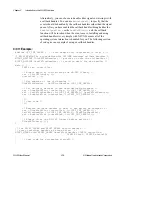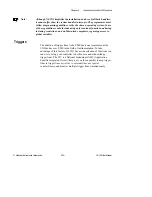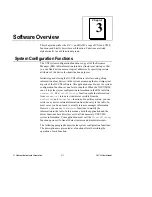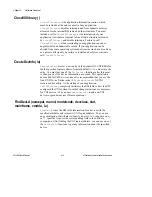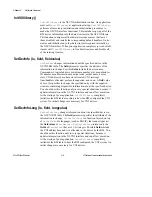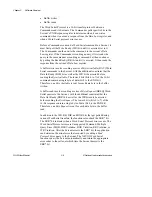
Chapter 3 Software Overview
© National Instruments Corporation
3-13
NI-VXI User Manual
Normally, you would use the
WScmd
function to send Word Serial
queries with the response automatically read (specified with respflag).
In cases when you need to inspect the Word Serial transfer at a lower
level, however, you can break up the query sending and query response
retrieval by using the
WScmd
function to send the query as a command
and using the
WSresp
function to retrieve the response. During the
interim period between sending the
WScmd
and
WSresp
functions, you
can check register values and other hardware conditions.
WSresp
polls
the RR bit before reading the response from the Data Low register.
After reading the response, it polls the Response register until the
WR bit is asserted.
WSsetTmo (timo, actualtimo)
WSsetTmo
sets the timeout period for all of the Commander Word
Serial Protocol functions. It sets the timeout value in milliseconds to
the nearest resolution of the host CPU. When a timeout occurs during a
Commander Word Serial Protocol function, the function terminates
with a corresponding error code.
WStrg (la)
WStrg
sends the Word Serial Trigger command to a message-based
Servant. Before sending the Trigger command (by writing to the Data
Low register),
WStrg
polls both Response register bits—Data In Ready
(DIR) and Write Ready (WR)—until asserted. You cannot use the
WScmd
function to send the Word Serial Trigger command (
WScmd
polls only for WR before sending the command).
WStrg
polls the
WR bit until asserted again after sending the Trigger command to
guarantee that no protocol errors occurred during the transfer.
WSwrt (la, buf, count, modevalue, retcount)
This function is the buffer write function.
WSwrt
writes a specified
number of bytes from a memory buffer to a message-based Servant
using the VXIbus Byte Transfer Protocol. The process involves
sending a series of Byte Available (BAV) Word Serial commands with
a single byte in the lower 8 bits of the command. Before sending the
BAV command,
WSwrt
polls both Response register bits—Data In
Ready (DIR) and Write Ready (WR)—until asserted. The modevalue
parameter in the call specifies whether to send BAV only or BAV with
END for the last byte of the transfer.

